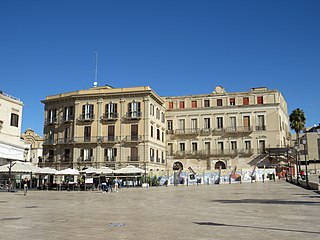
Bari is the capital city of the Metropolitan City of Bari and of the Apulia region, on the Adriatic Sea, southern Italy. It is the second most important economic centre of mainland Southern Italy after Naples. It is a port and university city, as well as the city of Saint Nicholas. The city itself has a population of 315,284 inhabitants, and an area of over 116 square kilometres (45 sq mi), while the urban area has 750,000 inhabitants. The metropolitan area has 1.3 million inhabitants.

Molfetta is a town located in the northern side of the Metropolitan City of Bari, Apulia, southern Italy.
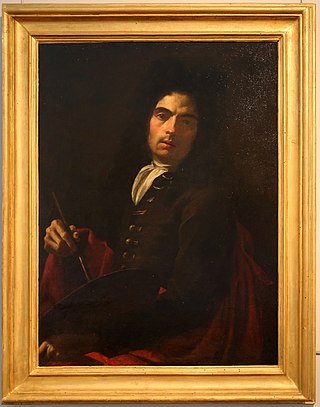
Corrado Giaquinto was an Italian Rococo painter.

Museo di Capodimonte is an art museum located in the Palace of Capodimonte, a grand Bourbon palazzo in Naples, Italy designed by Giovanni Antonio Medrano. The museum is the prime repository of Neapolitan painting and decorative art, with several important works from other Italian schools of painting, and some important ancient Roman sculptures. It is one of the largest museums in Italy. The museum was inaugurated in 1957.

The Pinacoteca di Brera is the main public gallery for paintings in Milan, Italy. It contains one of the foremost collections of Italian paintings from the 13th to the 20th century, an outgrowth of the cultural program of the Brera Academy, which shares the site in the Palazzo Brera.

Acquaviva delle Fonti is a town and comune of 20,446 inhabitants, in the Metropolitan City of Bari, in Apulia, Italy. Acquaviva is famous for its characteristic red onions, which have been awarded the DOP mark. The main monuments are the Palazzo de Mari, the Co-Cathedral of Sant'Eustachio and the ancient village. The town is located on the Murge plateau at an elevation of 300 metres (980 ft) above sea level, and is 26 kilometres (16 mi) from the Adriatic Sea and Bari, which is the biggest city of the region. The Ionian Sea is more than 45 kilometres (28 mi) to the south.

Casamassima is a town and comune of 19,786 inhabitants in the Metropolitan City of Bari, in Apulia, southern Italy. Is also called "The Blue Town". The town is located inland from the Italian coastline, thrives and is built on agriculture, primarily that of wine, olives and almond production. Founded around the seventh and eighth centuries, the village started as a Roman encampment, according to legend.

The Palazzo Buonaccorsi is an 18th-century aristocratic palace, now the civic museum of the town, located on Via Don Minzoni 24 in the historic center of Macerata, region of Marche, Italy.

The Museu Nacional de Belas Artes is a national art museum located in the city of Rio de Janeiro, Brazil. The museum, officially established in 1937 by the initiative of education minister Gustavo Capanema, was inaugurated in 1938 by President Getúlio Vargas. The museum collection, on the other hand, takes its rise in the transfer of the Portuguese Court to Brazil in the early 19th century, when King John VI brought along with him part of the Portuguese Royal Collection. This art collection stayed in Brazil after the King's return to Europe and became the core collection of the National School of Fine Arts. When the museum was created in 1937, it became the heir not only the National School collection, but also of its headquarters, a 1908 eclectic style building projected by Spanish architect Adolfo Morales de los Ríos.
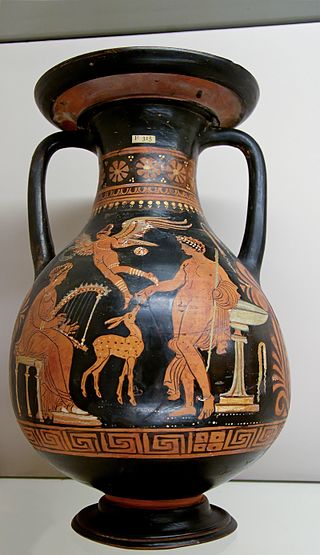
Apulian vase painting was a regional style of South Italian vase painting from ancient Apulia in Magna Graecia. It comprises geometric pottery and red-figure pottery.
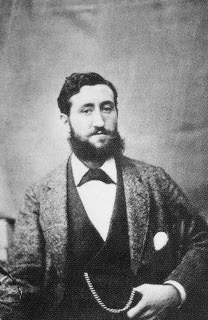
Serafino De Tivoli was an Italian painter of the Macchiaioli group, often referred to as "the father of the macchia" in recognition of his crucial influence on the group's innovative technique.

Guido Marzulli is a figurative Italian painter.
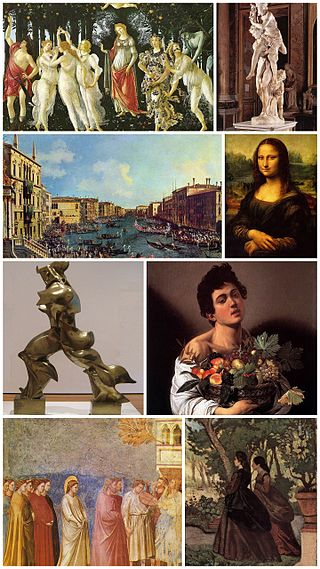
Italian Rococo art refers to painting and the plastic arts in Italy during the Rococo period, which went from about the early/mid-18th to the late 18th century.

The Museum of Fine Arts of Rennes is a municipal museum of fine arts in the French city of Rennes, the capital of Brittany. Its collections range from ancient Egypt antiquities to the Modern art period and make the museum one of the most important in France outside Paris, notably for its paintings and drawings holdings.

The Pinacoteca Nazionale is a national museum in Siena, Tuscany, Italy. Inaugurated in 1932, it houses especially late medieval and Renaissance paintings from Italian artists. It is housed in the Brigidi and Buonsignori palaces in the city's center: the former, built in the 14th century, it is traditionally identified as the Pannocchieschi family's residence. The Palazzo Bichi-Buonsignori, although built in the 15th century, has a 19th-century neo-medieval façade based on the city's Palazzo Pubblico.

The musée Fesch is the central museum of fine arts in Ajaccio on Corsica. Located within the gated Palais Fesch, it is in the town's Borgu d'Ajaccio quarter. It was established by Napoleon I's uncle, cardinal Joseph Fesch, in Fesch's birthplace.
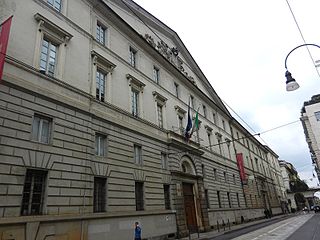
The Accademia Albertina di Belle Arti is an institution of higher education in Turin, Italy

The Pinacoteca Comunale ofCittà di Castello is the main museum of paintings and arts of Umbria Italian Region, alongside the Perugia's National gallery, and it's housed in a renaissance palace, generally preserved in its original form.

Museo Civico di Teramo is an art museum in Teramo, Abruzzo.

The culture of Apulia, the region that constitutes the extreme southeast of the Italian peninsula, has had, since ancient times, mixed influences from the West and the East, due to its strategic position near the transition zone between these two cultural regions. Its location, on the west coast of the Adriatic and Ionian seas, the natural southern border between Western Europe and the Balkans and Greece, made it a bridge to the East since antiquity, and in the Middle Ages, it was a cultural frontier between the Roman-Germanic West and the Greek-Byzantine East.























